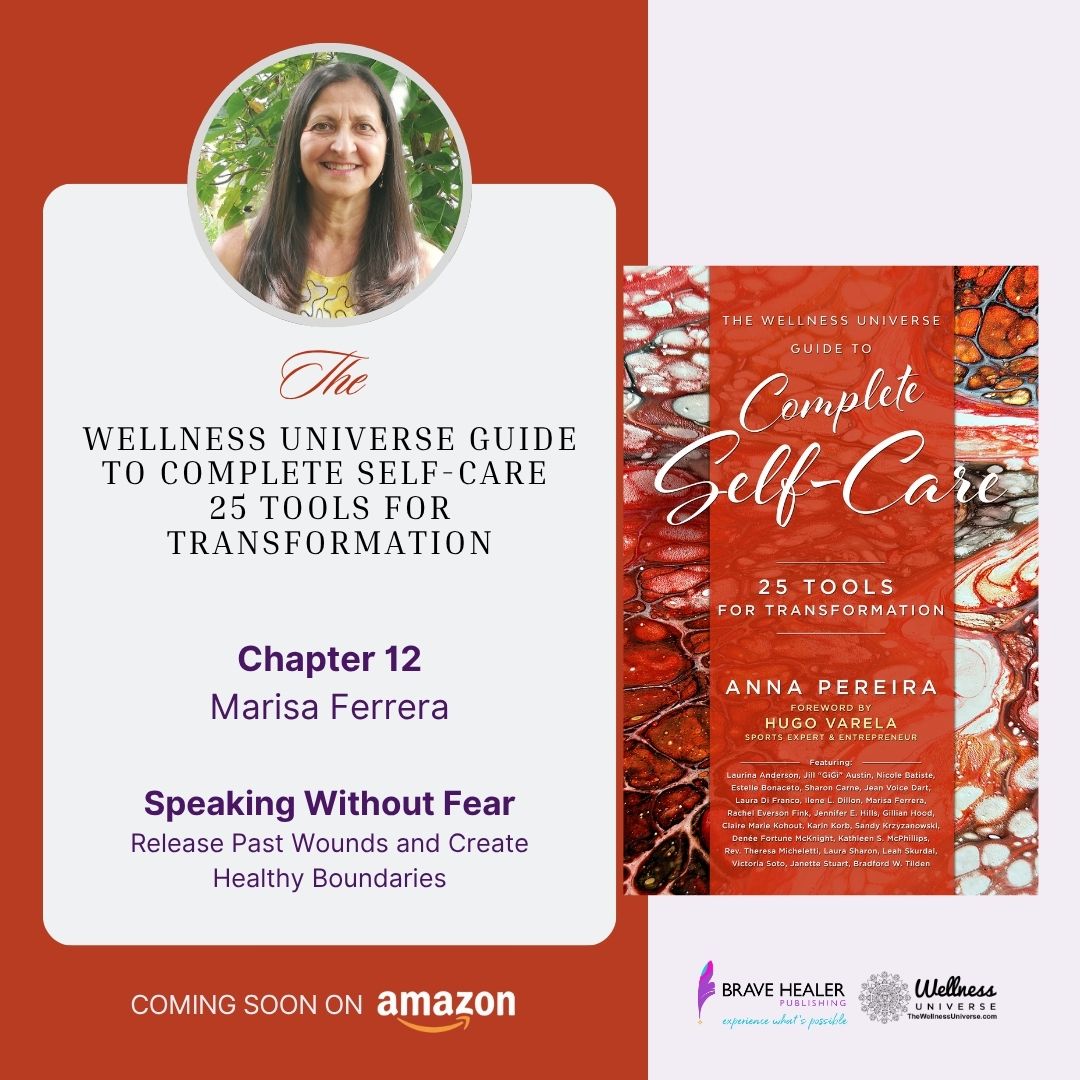
by Marisa Ferrera | Jun 11, 2025 | Relationships, Special Days
Father’s Day can be a joyful celebration—or a painful reminder.
For many women, their relationship with their father is one of the most powerful influences in their lives. When that bond is loving and secure, it often lays the foundation for confidence, self-worth, and the ability to form healthy, trusting relationships. But when the relationship is strained, distant, or painful, it can leave deep emotional wounds that show up in subtle—and not so subtle—ways throughout life.
I know this from personal experience.
For years, I carried the pain of unresolved conflict with my father. I longed for his approval, feared his judgment, and struggled to express my truth without fear. That inner turmoil spilled into other relationships—making it harder for me to set boundaries, trust myself, or fully step into my power.
But that’s not the end of my story.
Through deep personal healing, I found the courage to face those wounds and have a conversation with my father that changed everything. It wasn’t easy—but it was one of the most liberating moments of my life. I finally spoke without fear, without blame, and with an open heart. That one moment marked the beginning of a profound transformation in our relationship—and in me.
 I share this story in the upcoming book, The Wellness Universe Guide to Complete Self-Care: 25 Tools for Transformation, where I contribute a chapter titled “Speaking Without Fear: Release Past Wounds and Create Healthy Boundaries.” My chapter offers both my personal story and a practical tool you can use to heal past wounds—especially those involving family.
I share this story in the upcoming book, The Wellness Universe Guide to Complete Self-Care: 25 Tools for Transformation, where I contribute a chapter titled “Speaking Without Fear: Release Past Wounds and Create Healthy Boundaries.” My chapter offers both my personal story and a practical tool you can use to heal past wounds—especially those involving family.
Join The Book Launch Team
If my story resonates with you and you’d like to support this powerful book and message, I’d love for you to join the 25 Tools for Transformation book launch team.
As a launch team member, here’s what’s required:
- Read the advanced PDF reader copy of the book before anyone else! (You’ll receive a free copy before the launch.)
- Purchase the eBook on launch day—it’s specially priced at just $1.99!
- Leave your honest review on Amazon to help spread the word and support this mission.
If you’d like to support this launch and discover the power of self-care while enjoying the chance to win your share of over $20,000 in fantastic prizes, join before June 24 so you don’t miss the email with your early copy of the book.
This Father’s Day, I invite you to reflect on your relationship with your father. Whether it’s filled with love or marked by pain, know that healing is possible—and your voice matters.

by Marisa Ferrera | May 8, 2025 | Relationships, Special Days
A Heartfelt Practice for Healing and Wholeness
Mother’s Day is often a time of celebration, reflection, and deep emotion. For some, it’s a joyful occasion filled with love and connection. For others, it can stir up memories of loss, longing, or relationships that never felt fully nurturing.
No matter what your experience has been, I invite you to consider a beautiful, healing practice this Mother’s Day: writing a letter to the mother you needed.
This isn’t about blame or judgment. It’s about acknowledging the parts of you that may still be waiting to feel seen, safe, and supported. It’s about honoring the wisdom and strength you’ve cultivated on your journey—and offering love to the little girl inside you who may not have always received what she needed.
Why This Practice Can Be Transformational
Writing to the “ideal mother” gives your inner child a voice. It allows you to:
- Express emotions you may have held in for years.
- Give language to your needs and desires.
- Reclaim your power by becoming the nurturing, loving presence you may have longed for.
This practice is about offering yourself the compassion, understanding, and unconditional love that every child deserves—and that every adult can learn to give to themselves.
Your Invitation: A Letter from the Heart
You might begin with words like these:
Dear Mom,
If I could have had the mother I needed, you would have…
…held me when I cried, without needing to fix me.
…told me I was enough, just as I was.
…asked about my feelings and truly listened.
…reminded me that my voice mattered.
I now offer those words to myself. I now become the mother I needed. With love, grace, and compassion, I reclaim all parts of me and celebrate the woman I’ve become.
Take your time with this. Find a quiet space, perhaps light a candle, and allow your heart to guide your pen. You may be surprised by what comes through.
Mothering Yourself Is a Sacred Gift
Regardless of whether your mother is still with you or what your relationship has looked like, you have the power to mother yourself in ways that feel deeply nurturing and true.
This Mother’s Day, celebrate the loving, wise, and powerful woman you are. Celebrate the healing you’ve already done—and the freedom that comes when you choose to speak your truth, honor your boundaries, and give yourself the love you’ve always deserved.

by Marisa Ferrera | Mar 20, 2025 | Relationships, Special Days
[image created by ChatGPT]
Today, on International Day of Happiness, we are invited to reflect on what truly brings us joy—not fleeting moments of pleasure, but the kind of deep, soul-nourishing happiness that comes from authentic connection, peace within ourselves, and harmonious relationships with those we love.
Yet for many, family relationships—especially with adult family members—can feel more like a source of stress and frustration than joy. You may find yourself triggered by old wounds, caught in cycles of conflict, or feeling unseen and unheard. And while it can feel easier to avoid or suppress the pain, I invite you to see today as an opportunity to reclaim your power and your peace by taking steps toward healing and transforming these relationships.
Because true happiness begins with inner peace—and from that place, we can create ripples of healing and love that extend far beyond ourselves.
The Path to Happiness Begins Within
The first step in improving any challenging relationship is to remember this truth: You are not powerless. Even if you cannot change another person, you can always choose how you respond. You can choose to rise above the drama and act from a place of love, clarity, and healthy boundaries.
So much of our pain in family relationships comes from holding onto unmet expectations, unhealed wounds, and the hope that others will behave the way we want them to. But when we shift our focus inward, we find the freedom to release what no longer serves us and step into the magnificence of who we truly are—a divine being, worthy of love, respect, and joy.
Three Soulful Steps to Heal and Enhance Family Relationships
1. Honor Your Feelings, Without Letting Them Control You
Your emotions are sacred messengers. When you feel anger, sadness, or frustration in a family dynamic, pause and ask yourself: What is this feeling showing me about what I need or value?
Instead of reacting from a triggered place, take time to breathe, reflect, and respond from your higher self. This may mean stepping away for a moment, journaling your thoughts, or speaking your truth with love when the time is right.
Remember: You have the right to feel everything—and the power to choose peace.
2. Create Loving Boundaries That Reflect Your Worth
Many women I work with struggle to create boundaries because they fear rejection or feel guilty. But healthy boundaries are not walls—they are bridges that create safety, clarity, and respect in our relationships.
Ask yourself:
- What am I no longer willing to tolerate?
- How can I express my needs with compassion and firmness?
- What boundaries will support my happiness and well-being?
Know that when you honor yourself, you invite others to meet you at a higher level of love and respect.
3. Choose Compassion Over Judgment
Every family member is on their own soul journey, shaped by their wounds, fears, and limitations. While this doesn’t excuse harmful behavior, it can help you to release resentment and move into a space of compassionate understanding.
Compassion doesn’t mean you condone their actions—it means you free yourself from the burden of anger and choose love over bitterness. As you shift your energy, you create space for healing and even the possibility of reconciliation.
A Gift to Yourself and Your Family
Healing family relationships is not always easy, but it is one of the most profound gifts you can give yourself—and those you love. It opens the door to true happiness rooted in peace, empowerment, and connection.
Today, let’s celebrate International Day of Happiness by making a commitment to ourselves:
- To choose peace over conflict.
- To honor our needs and our voice.
- To release what no longer serves us and invite love to guide our path.
No matter how challenging your family dynamics may be, remember this: You have the power to magnify your magnificence, heal your heart, and create relationships that uplift your spirit.

by Marisa Ferrera | Mar 8, 2025 | Relationships, Special Days
Women’s Day is a time to celebrate the beauty, strength, and resilience of women worldwide. It’s a day to honor how far we’ve come, the wisdom we carry, and the powerful ways we contribute to the world. But amidst the celebrations, I want to invite you to take a step inward—to reflect on the relationships you have with the women in your life and ask yourself, Is there healing that needs to take place?
As women, we have the capacity to nurture and uplift one another, yet too often, unresolved wounds create barriers between us. Whether it’s tension with your mother, unresolved conflict with a sister, or lingering resentment toward a friend, holding onto anger, judgment, or resentment only keeps us stuck. Today, I encourage you to open your heart to the possibility of releasing these burdens and embracing deeper connection and peace.
The Power of Letting Go
Letting go does not mean condoning hurtful behaviour or pretending past pain didn’t happen. It means choosing to free yourself from the weight of anger and judgment so you can experience more love, peace, and joy. When we hold onto resentment, we are the ones who suffer most. It drains our energy and keeps us trapped in the past.
Forgiveness is not about the other person; it’s about YOU. It’s about reclaiming your power and choosing to no longer let past wounds dictate your present and future. It’s about softening your heart while still honoring your boundaries and self-worth.
A Gentle Path to Healing
Healing relationships, especially those with our mothers, daughters, sisters, or close female friends, can feel overwhelming. But you don’t have to do it all at once. Here are a few steps to guide you:
1. Acknowledge Your Feelings Without Judgment
Give yourself permission to feel whatever is there—hurt, sadness, frustration. Recognizing and validating your emotions is the first step toward healing.
2. Shift Your Perspective
Ask yourself: What might have led this person to act the way they did? While understanding doesn’t excuse hurtful behaviour, it can help you release some of the pain attached to it.
3. Choose Compassion Over Judgment
Every woman carries her own wounds, struggles, and fears. When we replace judgment with compassion, we open the door to understanding and, possibly, reconciliation. Give yourself permission to feel whatever is there—hurt, sadness, frustration. Recognizing and validating your emotions is the first step toward healing.
4. Practice Letting Go Daily
Letting go is a process, not a one-time decision. Each day, choose to release a little more—through journaling, meditation, prayer, or simply setting an intention to send love rather than resentment.
5. Create Space for a New Beginning
If and when it feels right, consider extending a small gesture of kindness toward the woman you’ve struggled with. It might be a simple message, a heartfelt conversation, or even just holding her in your thoughts with love.
The Ripple Effect of Healing
When we choose to heal our relationships with other women, we create a ripple effect. We break cycles of pain and replace them with understanding and love. We set an example for younger generations, teaching them that women are not each other’s rivals but each other’s greatest allies.
This Women’s Day, I invite you to take a step toward releasing judgment, resentment, and anger. Open your heart to the possibility of healing. You deserve to experience the freedom, joy, and love that come from letting go.
Let’s rise together, not just as individuals but as a collective sisterhood, lifting each other up in love and grace.
If you’re struggling with letting go of judgment, anger, or resentment and would like support on your healing journey, I invite you to book a complimentary call with me. Together, we can explore how I might be able to help you move forward with more peace and love. Click here to schedule your free session.

by Marisa Ferrera | Feb 13, 2025 | Relationships, Special Days
Valentine’s Day tends to focus on romantic love, but at its core, it’s about all forms of love—including the deep connections we share with family. What if we carried the spirit of Valentine’s Day into every single day? By nurturing our relationships, practicing open communication, and creating healthy, loving boundaries, we can create a family environment filled with warmth and understanding long after February 14th has passed.
Tips to Help you Strengthen your Family Connections
1. Show Love in the Little Things
Love isn’t just about saying “I love you”—it’s about everyday gestures that show you care. Acknowledge your family’s efforts, express gratitude, and offer words of encouragement. Small things, like a warm hug, a thoughtful note, or simply putting your phone down and listening, can make a huge difference in strengthening your bond. Love is also about consistency—showing up for people when they need you, celebrating their wins, and being a source of support in tough times. Sometimes, it’s as simple as checking in with a quick text or making their favorite meal just because.
2. Make Time for Each Other
Life gets busy, and it’s easy to take family relationships for granted. Make a conscious effort to carve out quality time—whether it’s a weekly dinner, a shared activity, or just a walk together. What matters most isn’t the activity itself, but being fully present in the moment. If you live far from family, schedule regular phone or video calls to stay connected. It’s not about grand gestures; rather, it’s the little things that build meaningful relationships over time. Even a five-minute check-in or a handwritten letter can make someone feel cherished.
3. Practice Compassion and Forgiveness
No family is perfect, and disagreements are inevitable. Instead of holding onto resentment, see conflict as an opportunity to grow and heal. When tensions arise, listen with an open heart, express your feelings calmly, and focus on understanding rather than winning. Put yourself in the other person’s shoes—everyone has their struggles, and sometimes a little patience can go a long way. A genuine apology can mend wounds, and choosing to let go of minor grievances can create a more peaceful family dynamic. Compassion means choosing love over ego and prioritizing harmony over being right.
4. Create Healthy Boundaries
Strong relationships thrive on mutual respect and clear boundaries. Boundaries aren’t about shutting people out—they’re about ensuring love and respect flow freely without resentment. Communicate your needs honestly and kindly, and respect the limits of others as well. For example, if you need space after a long day, express that with kindness rather than frustration. If a family member tends to overstep, set gentle yet firm boundaries that honor your emotional well-being. Boundaries create clarity, reduce misunderstandings, and foster deeper connections based on mutual respect.
5. Celebrate the Everyday Moments
You don’t need a special occasion to celebrate the people you love. Acknowledge milestones, both big and small, and take time to appreciate each other. A kind word, an unexpected note, or a shared laugh can make family members feel seen and valued. Make it a habit to notice the good in your family members and verbalize it—tell them when they’ve done something well, thank them for their kindness, and remind them of their strengths. Gratitude fosters closeness, and when family members feel appreciated, they’re more likely to show love in return.
6. Lead with Love
Creating a loving family atmosphere starts with you. When you choose patience, kindness, and empathy, you set the tone for those around you. Your energy influences the way your family interacts, encouraging warmth and understanding in every interaction. Lead by example—if you want more love in your family, be the first to give it. Offer encouragement, be an active listener, and express your love freely. The way you show up in your relationships will inspire others to do the same.
7. Incorporate Acts of Service
One of the most profound ways to show love is through acts of service. Doing something thoughtful for a family member—whether it’s helping with chores, running an errand, or simply making them a cup of tea—demonstrates care in a tangible way. It’s often the unspoken actions that speak the loudest. Pay attention to what your loved ones need and find small ways to ease their burdens. Love isn’t just in words; it’s in the everyday actions that make life a little easier for those around us.
8. Keep Communication Open and Honest
Honest and open communication is the foundation of any strong relationship. Don’t be afraid to express your feelings, and encourage your family members to do the same. Create a safe space where everyone feels heard and respected. If there’s tension, address it with kindness instead of avoidance. Clear, heartfelt communication prevents misunderstandings and deepens trust, allowing love to flourish naturally.
9. Create Meaningful Traditions
Traditions bring families together and create lasting memories. Whether it’s a Sunday breakfast, an annual family trip, or a game night, traditions give family members something to look forward to and strengthen their bond. You don’t need anything elaborate—simple rituals, like writing letters to each other on special occasions or watching a favorite movie together, can become cherished family traditions that deepen connection over time.
10. Extend Love Beyond Your Immediate Family
Love isn’t limited to immediate family—extend it to relatives, close friends, and even neighbours. Small acts of kindness, like checking in on an elderly family member or supporting a friend in need, create ripples of love that enrich all your relationships. The more love you give, the more you create an environment where love thrives naturally.
This Valentine’s Day, let’s go beyond flowers and chocolates. Let’s commit to making love a daily practice in all our relationships, creating strong and lasting connections that bring joy, kindness, and appreciation—every single day of the year. Love is not a once-a-year event; it’s a way of living that enriches both you and those around you.
If you’d like personalized support in navigating family dynamics, creating healthy boundaries, and/or improving communication, I’d love to help. Schedule a complimentary call with me, and let’s create a plan to bring more love and peace into your family relationships.
Schedule Your Complimentary Call Here

by Marisa Ferrera | Jan 1, 2025 | Relationships, Special Days
As the New Year approaches, there’s a certain magic in the air. It’s a time of reflection, hope, and renewal—a perfect opportunity to set meaningful intentions that align with your heart’s deepest desires. For many women, the start of a new year brings the hope of mending broken connections, healing old wounds, and creating healthier, more fulfilling relationships with family members.
If you’ve been struggling with a dysfunctional family relationship, you’re not alone. Family dynamics can be one of the most challenging areas of life to navigate. Yet, they also hold incredible potential for growth, healing, and transformation. As you step into 2025, consider setting an intention to heal from the pain of the past and create healthier dynamics with the people who matter most to you.
Here are five empowering steps to guide you on this journey:
1. Reflect on Your Relationship Patterns
Healing begins with awareness. Take some time to journal about the family relationships that feel difficult or painful. What patterns do you notice? Are there recurring conflicts, unspoken resentments, or unhealthy boundaries?
Be compassionate with yourself as you explore these dynamics. Remember, awareness is not about assigning blame but understanding where things stand so you can move forward with clarity.
2. Set a Clear and Compassionate Intention
Intentions are powerful because they focus your energy and attention. Instead of making a resolution like, “I will fix my relationship with my mother,” try setting a more open and compassionate intention, such as, “I will work on creating healthier boundaries and fostering mutual understanding in my family relationships.”
This subtle shift allows space for growth and healing without placing pressure on achieving a specific outcome.
3. Learn and Practice Healthy Boundaries
Boundaries are the foundation of any healthy relationship. They protect your well-being and communicate your needs clearly and respectfully. If setting boundaries feels challenging, start small. Practice saying “no” to things that don’t serve you, and express your feelings in ways that honor both yourself and the other person.
Remember, boundaries are not about controlling others; they’re about taking responsibility for your own emotional health.
4. Transform Conflict into Opportunities for Growth
Conflict doesn’t have to be destructive. When approached with intention, it can become a doorway to deeper understanding and connection. Instead of avoiding difficult conversations, learn to navigate them with empathy and curiosity.
The next time a disagreement arises, pause and ask yourself, “What is this conflict teaching me about myself and this relationship?” This mindset shift can open new possibilities for healing.
5. Seek Support and Resources
You don’t have to go through this journey alone. Whether it’s through a trusted friend, therapist, coach, or support group, having a safe space to share your experiences can make all the difference. There are also many books, workshops, and online resources available to help you build the skills needed to heal and grow.
Here are a couple of FREE resources to get you started:
Create Healthy Boundaries Guide
Resolve Conflicts Peacefully Guide
A Heartfelt Invitation for 2025
As you set your intentions for the year ahead, remember that healing is a journey, not a destination. Be gentle with yourself and celebrate every small step forward. Even the act of setting this intention is a powerful declaration of your commitment to growth and self-love.
Imagine what your life could look like at the end of 2025: healthier boundaries, deeper connections, and the freedom to show up authentically in your family relationships. This vision is within reach, and it all begins with the intention you set today.
Here’s to a year of healing, growth, and transformation. May 2025 be the year you reclaim your power, nurture your heart, and create the loving, supportive family dynamics you deserve.
If you’re committed to healing your dysfunctional family relationships this year, I invite you to schedule a complimentary relationship renewal discovery session with me. Let’s explore together whether or not we’re a good fit for working together.

 I share this story in the upcoming book, The Wellness Universe Guide to Complete Self-Care: 25 Tools for Transformation, where I contribute a chapter titled “Speaking Without Fear: Release Past Wounds and Create Healthy Boundaries.” My chapter offers both my personal story and a practical tool you can use to heal past wounds—especially those involving family.
I share this story in the upcoming book, The Wellness Universe Guide to Complete Self-Care: 25 Tools for Transformation, where I contribute a chapter titled “Speaking Without Fear: Release Past Wounds and Create Healthy Boundaries.” My chapter offers both my personal story and a practical tool you can use to heal past wounds—especially those involving family.





